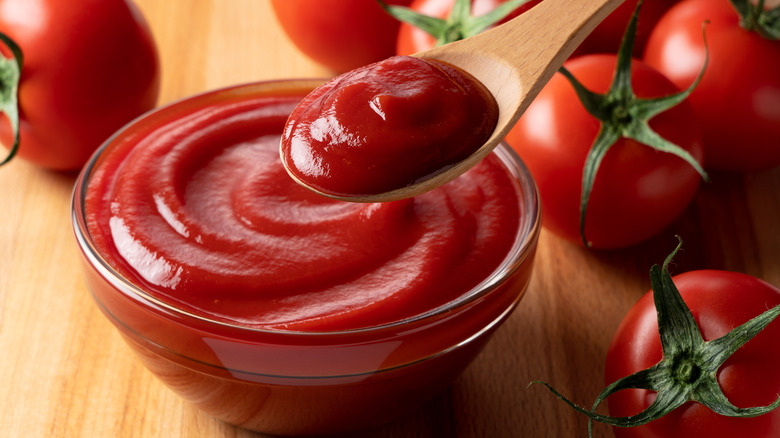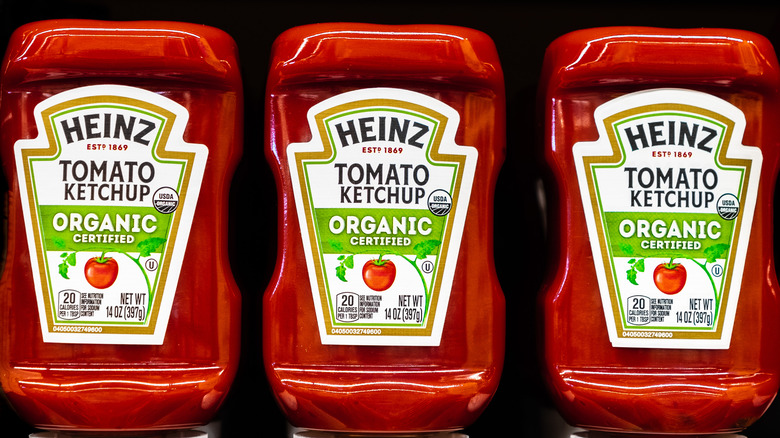Fancy Vs. Regular Ketchup: What's The Difference?
We may receive a commission on purchases made from links.
It's the go-to accompaniment for fries. It can be used to clean copper and silver, notes Cookist. According to Bob Schwarz, it has no place on a hot dog. Ketchup is a favorite of young and old alike, prized for its tangy sweetness that frames and amplifies the flavors of rich and starchy foods. It's a condiment that seems rather singular in its ideal, constituting a market occupied by a few masters of the craft and a handful of boutique offerings. So, what then makes fancy ketchup "fancy"?
According to the USDA, tomato catsup comes in three different grades, A, B, and C. Only those ketchups containing over 33% solids by weight and scoring over 85 points on a review of color, consistency, absence of defects, and, of course, flavor can carry the mantle of Grade A or "Fancy." Grade B and C ketchups — "Extra Standard" and "Standard" respectively, in industry parlance — are those found to have a reduced quantity of solids by weight and a lower score on the grading test. In practical terms, this means "fancy" ketchups are smoother, firmer, largely free of noticeable bits of tomato, and optimally balanced between sweet and sour notes (via Mental Floss).
Most name-brand ketchups, such as Heinz, whether they tout the label or not, are technically "Fancy." "Extra Standard" ketchups tend to be obscure brands such as Bella Vista and Pacific Coast, available only via food service purveyors. "Standard" ketchups seem elusive to track down.
The history of ketchup
A History Channel exploration finds a possible antecedent to ketchup in China, circa 300 B.C. Long before Europeans extracted the tomato from the "new world," koe-cheup was a fermented slurry of fish and soybeans, not unlike modern fish sauce. An entry in the Online Etymological Dictionary, though, points to still-popular kecap manis, a sweetened, spiced soy sauce from Indonesia, as the original ketchup. Regardless which is more technically true, both of these sauces, through fermentation and robust salting, were ideal for long voyages at sea and, in time, made their way to the west.
Once in England, ketchup began to take on a European feel, according to Slate. Fish played less of a role, with mushrooms — and even walnuts — taking center stage. Cloves, mace, pepper, and ginger began to bring the condiment closer to the form we recognize today. And, lest you think this is all ancient history, there are still quite a few mushroom ketchups commercially available, such as British import Geo Watkins.
By the early 19th century, tomato ketchup was catching on, with recipes appearing in cookbooks of the era. This was, according to the Tomato Gardening Guru, despite the raw fruit being still viewed as poisonous, or at least suspect, due to its association with the nightshade family of plants. As a processed food, tomato ketchup was seen as purged of its noxious attributes. Heinz, the nation's best-selling ketchup, tomato or otherwise, rolled out in 1876 (via Delish).
Fancy by any other name
Beyond the legal definition of "fancy" ketchup, what's to be made of the crop of upstarts looking to challenge major manufacturers' condiment primacy?
In a 2004 New Yorker column, Malcolm Gladwell highlights the uphill battle faced by gourmet ketchup producer World's Best as they try to divine why their sauce is failing to gain a following. In a head-to-head match up with Heinz, sensory analysts at Kansas State University found that it boiled down to the amplitude of the constituent flavors, specifically the balanced, almost symphonic high amplitude of Heinz and the low amplitude profile of World's Best, in which certain flavors outshone their bottle mates.
Still though, gourmet ketchups persist. A 2018 Chicago Tribune taste test resulted in Sir Kensington's edging out stalwarts with more name recognition. This sea change in the condiment game could be why even titans of the field introduced high-end variants to defend their flanks. Another 2018 taste test, this time by the editors of Epicurious, put Heinz at the top of the heap, but not the flagship brand. Rather Heinz Organic, with its faint "spicy kick," took the crown.
Whether you like your ketchup name brand or small batch, whether or not the word "fancy" tickles your fancy, or whether you'll own up to slathering it on a hot dog, one thing is certain: Ketchup is one of the most popular condiments in the U.S. But it's not number one. According to FoodBeast, that spot belongs to its creamy, refrigerated friend mayonnaise.


